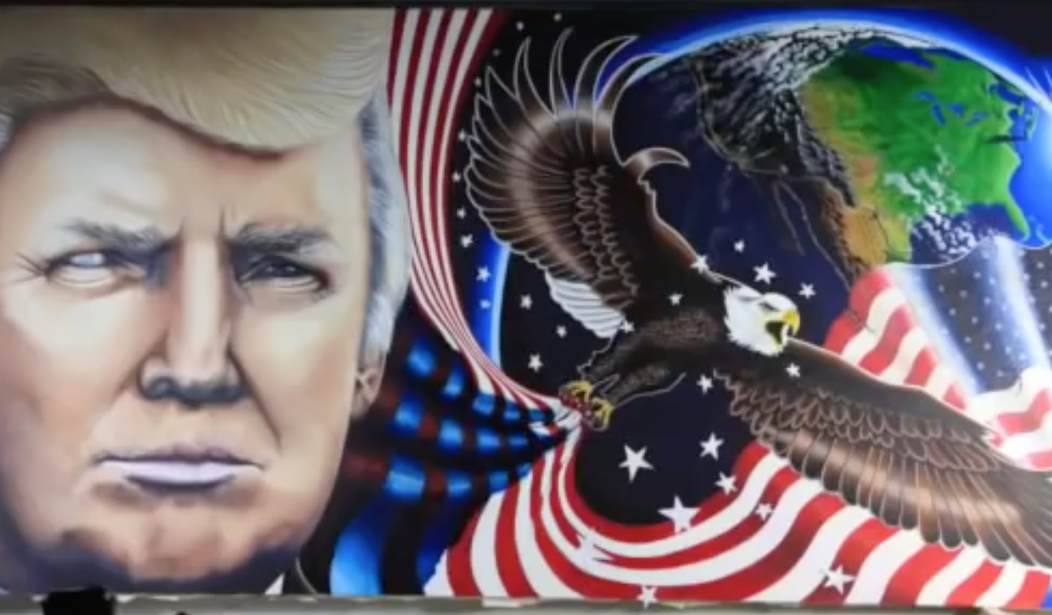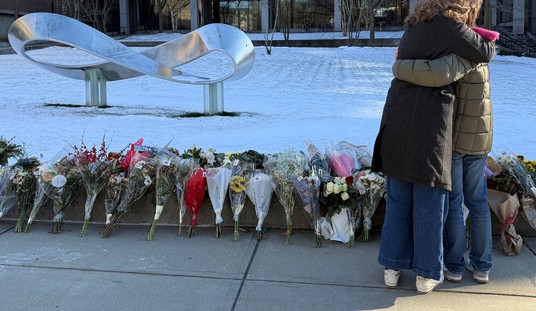Julian Raven, a British immigrant to the U.S., got his citizenship in 2015 while working on his magnum opus, a humongous portrait of Donald Trump complete with a bald eagle rescuing an American flag. He brought a picture of the portrait to Trump Tower and met Trump in person. He took the portrait on tour in Iowa. He showed the portrait in Los Angeles and Washington, D.C. When he submitted this historic artwork for consideration by the Smithsonian, he expected a fair hearing according to the Smithsonian’s own rules. Instead, he got a politically-motivated rejection, and an insult from the National Portrait Gallery director herself.
Raven filed a lawsuit, and he has appealed his case all the way to the Supreme Court. There is good reason to think the Court may take up his case, since it would give the Court an opportunity to clear up the Smithsonian’s oft-confused legal status.
While Raven told PJ Media he thinks his portrait should be in the National Portrait Gallery in Washington, D.C., he insisted that the legal battle is not about forcing the Smithsonian to display it but merely getting a fair hearing for it. In rejecting his portrait out of hand, the Smithsonian allegedly violated its own rules and discriminated against him based on his conservative views.
The vision for Raven’s portrait came a few days after Donald Trump announced his presidential run. “I have a picture in my mind of this falling American flag, an eagle swooping in to catch the flag, rescuing it, and the words, ‘unafraid and unashamed,'” he recounted. The image of Trump’s face with this eagle and the American flag kept nagging at him.
Raven was familiar with Shepard Fairey’s famous “Hope” poster with Barack Obama before his election in 2008, but he was more focused on a metal sculpture he was working on. Even so, the image kept returning to his mind.
One Friday night, the artist told his 13-year-old daughter he was working on a painting of an eagle and she asked — completely out of the blue — “Why don’t you give the painting of the eagle to Donald Trump so he can hang it at the White House?”
The very next morning, he saw a video of Trump with a bald eagle on his arm.
“I was gobsmacked,” Raven told PJ Media. “‘No way!’ I thought, to be honest with you, that I was being hoaxed. Out of all these 23 candidates, one man decides to have a bald eagle perch on his arm that morning.”
He was convinced that he had to make this vision a reality. “Within half an hour, I was in my car, driving down to my art studio. For five to six weeks, it literally consumed me, morning, noon, and night. When I saw my wife and kids, they thought I was someone else. I painted virtually 24-7.”
He did take one break, however — to take his oath and become a U.S. citizen.
Raven described the work as a mystical experience. “I didn’t know what I was doing. I painted as I was inspired; things I had not even thought of. It came out of me as I was painting this painting. This drama of snatching, rescuing, saving the United States. And Trump was portrayed as president,” he said. The work included symbolism — an aborted baby in the tear of the flag, a wall on the southern border of the U.S. The portrait was like a prophecy.
When he finished the painting and displayed it to friends, “the reactions were visceral.” The owner of a local hockey arena told the artist that if he could show it to Trump, he could display it in the hockey arena for free, to hold a rally there.
Raven sent a picture of his work to the campaign, but the campaign wasn’t interested. In November 2015, he held a small rally to unveil his work locally, but it did not generate much traction.
At the end of November, the artist made a larger canvas print of his work and set off for Trump Tower. He aimed to be part of the crowd at a meeting between the candidate and black pastors, but he heard the meeting was canceled. Dejected, he was about to leave, but his wife encouraged him to try again. The events that followed were surreal.
“I walk into Trump Tower, all the media is outside. There’s no one in the lobby except [Trump lawyer] Michael Cohen and [black megachurch pastor] Darrell Scott,” he recalled. “Darrell Scott turns to me and says, ‘You’re late.'” They travel up the iconic gold-plated elevator and Trump himself took the seat directly in front of Raven. After the meeting, he got to meet the candidate in person.
“The room was full of people who had faith. It was clear to me that God’s hand was on this man,” Raven recalled.
After that meeting, the artist set off for Iowa. He took a 5,000-mile journey to the Hawkeye State, showcasing his portrait “for the whole month of January right up to the caucuses.”
Raven set up shop in the west part of Iowa and the campaign did not follow him. “Once the caucuses came, I had actually won two of the three districts. All of the surrounding counties went to Ted Cruz,” he recalled.
From February on, the artist held rallies in New York state, hosting visitors at his studio. In March, he got an email from Yosi Sergant, the publicist who gave Fairey the idea for his Obama “Hope” poster. Raven recalled Sergant saying, “I hate Trump, but your painting is a vision of hope and I want it in my show at PolitiCon 2016.” The shipping company refused to haul it to Los Angeles, so Raven drove it there himself.
“They hung the painting on the wall with the Obama ‘Hope’ poster. It was a big thing for me,” the artist said. Most reactions were hostile to Trump but appreciative of the art. “They would yell and scream and curse Trump but say, ‘That’s a great painting, man!'”
Lynne Patton made a video for the Republican National Committee in Cleveland, and the video included Raven. The new citizen attended as an alternate delegate.
After Trump won, the artist didn’t know what to do next. “I prayed and asked, ‘God, what do I do?’ And I remembered what people had said.”
In New York, a woman had told him, “This should be in the Smithsonian.” In Iowa, another woman said, “This should be in the Smithsonian.” One man in Los Angeles had said the same thing.
When a new president is inaugurated, the National Portrait Gallery showcases political art about that president. Raven filled out an application, got some letters of recommendation from local elected officials, and sent it in.
The artist called Kim Sajet, director of the National Portrait Gallery, to follow up. A staffer told him she was not in the office. Yet to his surprise, the gallery called right back — it was Sajet herself.
“In a very condescending attitude, she asked, ‘Are you calling about the painting with the eagle and the flag?'” First, she told him it’s too big. “I couldn’t believe such an arbitrary objection.” The National Portrait Gallery had hung two enormous portraits of Obama for his inauguration in 2013. Next, she said the portrait is “not from life.” Yet the gallery hung the Obama “Hope” poster in 2009 and 2013, and that poster wasn’t taken from life, either. In fact, a photographer had sued Fairey for a copyright violation after he copied a professional photo.
Yet Sajet insisted that the “Hope” poster was from life. “This woman is having a meltdown and refuses to back down,” Raven recalled. He proceeded to point out that the Smithsonian’s written standards of portraiture acceptance say an image “should be the best likeness of the individual taken from life, if possible.”
Sajet went on to object to the portrait because it was “too pro-Trump” and “too political.” When Raven pointed out that the gallery hung the Obama “Hope” poster, she replied, “That was an iconic image.”
According to the written policy, a portrait’s inclusion depends on the historical value of the event and the individual involved in the event, not the artistic merit of the portrait or the fame of the artist involved. Rather than evaluating the artwork by these criteria, Sajet created arbitrary standards to reject his work, Raven alleged.
Finally, Sajet insulted the artist’s work and dared him to appeal her decision.
“The painting is no good,” she said. “I am the director of the National Portrait Gallery. Your application will go no further. You can appeal my decision all you want.”
Challenge accepted! “I think she’s really regretted that she said that,” Raven told PJ Media. “Now, I have appealed it — all the way up to the Supreme Court.”
Even so, the rejection hit him hard. “I felt so violated. I was physically silenced for two days. I could not bring myself to speak about what happened to my wife. I was clobbered,” he said. “I was outraged that she would have the gall to treat me like that.”
To make matters worse, Sajet went to the Women’s March after Trump’s inauguration — and she tweeted pictures from the National Portrait Gallery director Twitter page. “You think you can trample people’s rights and march in an anti-Trump protest,” he added, bitterly.
Raven sued, claiming the director had discriminated against him and violated his free speech and due process rights. U.S. District Judge Trevor McFadden dismissed Raven’s case, but condemned Sajet’s call as “odious … a professional insult … partisan and underserved, against Mr. Raven and his work.”
The artist has a reasonable hope that the Supreme Court will consider the case, however. The Court is most likely to take up cases that provide the opportunity to clear up confusing legal questions. While the Smithsonian was clearly established as a private institution — a trust managed by the federal government but not a part of the federal government — many consider it something like a federal agency.
“Even in its day there was this government overreach,” Raven told PJ Media, citing Smithsonian founding Secretary Joseph Henry, who wrote that the institution is “not a national establishment, as is frequently supposed, but the establishment of an individual.”
In 1971, Supreme Court Chief Justice Warren Burger acknowledged that he Smithsonian’s status “continues to confuse members of Congress, the courts, and the executive branch.”
In 2017, Jaclyn Kurin, daughter of Smithsonian Acting Provost Richard Kurin, wrote that the Smithsonian rests in a kind of “unconstitutional limbo” that violates the Constitution’s separation of powers doctrine.
Indeed, Raven argued that even Judge McFadden confused the Smithsonian’s legal status in his ruling.
“This entity status confusion has gone on for years,” the artist told PJ Media. “Smithsonian officials have become immune to prosecution. Everybody knows there’s a problem with this organization. There’s nothing new about this. It’s just never been pushed to this level before.”
Follow Tyler O’Neil, the author of this article, on Twitter at @Tyler2ONeil.









Join the conversation as a VIP Member